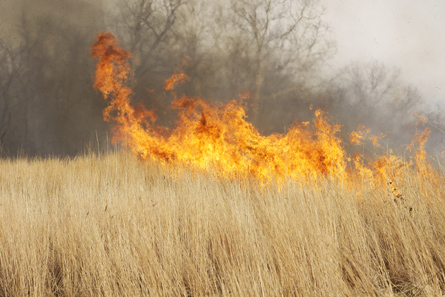Module 8
1. Module 8
1.27. Lesson 7
Module 8—Populations, Individuals, and Gene Pools
Lesson 7—Populations and Communities Changing Over Time—Succession
 Get Focused
Get Focused

© Bryan Eastham/6764477/Fotolia
Two hundred years ago it was possible to stand on a hill in parts of southern Alberta and see nothing but bison for ten kilometres in any direction. The vast herds were drawn to the verdant grasses that sprang up through the ashes after spring prairie fires. Prairie fires occured when spring lightning storms ignited the dry, yellow, grasses uncovered by melting snow. Fire would sweep across the prairie, returning the nutrients in the grass back to the soil, and clearing away dead matter so that light could germinate the new crop of wild grass seeds.
The bison came by the thousands to feast on the rich, new grass. The Aboriginal people depended on the buffalo to supply them with food and hides that would keep them alive for another year. When the fires of spring didn’t come, the bison stayed away. The indigenous tribes then had to travel to find the herds, or find alternative food sources.
Today, fires are not left to spread uncontrollably, and the wild prairie has been replaced in places by forest. Without fire, wild grasses were replaced by wild roses and thistles, and then wild raspberry bushes. Later, bushes like Saskatoon berry, dogwood, and hazelnut would move in to replace them. Still later, small trees like high-bush cranberry, pin cherry, and chokecherry would take over. Eventually, a forest of large aspen poplars would appear and remain indefinitely until the land was cleared for agriculture, urban development, or industry.
In this lesson the following focusing question will be examined:
- How do communities and their populations change or remain stable over time?
 Module 8: Lesson 7 Assignment
Module 8: Lesson 7 Assignment
Download a copy of the Module 8: Lesson 7 Assignment to your computer now. You will receive further instructions on how to complete this assignment later in the lesson.
The other questions and activities in this lesson are not marked by the teacher; however, you should still attempt all of the work offered here. These questions are designed to help you review important information and build key concepts that may be applied in future lessons.
Remember, you also have the option of trying additional questions from the textbook for further practice. Consult with your teacher for the answers to these questions. The Key will also provide you with many Diploma Exam-style multiple-choice, numerical-response, and written-response questions that will be an excellent review of the module. Practising your responses to these types of questions is good preparation for the Diploma Exam.